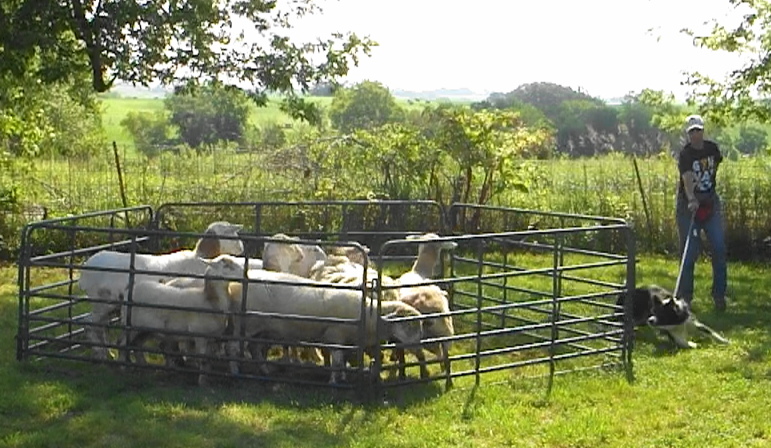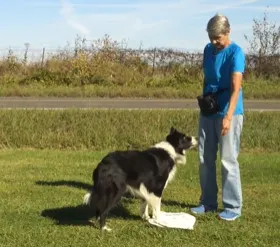PHD Blog 2 - The Gatekeeper
Sneak Peek - The Gatekeeper
Harried handler: I feel like I do not have my dog’s respect when in the pen with stock. She drags me to the pen and into the pen and to the start line. At home and in the agility ring she is incredibly responsive and respectful.
I am getting ready to bring home a few practice sheep which will help as I am feeling a bit stuck right now. It is hard going for a weekly lesson for an hour with no opportunity to practice in between.
It is easy to find yourself in this position. Away from livestock your dog shows great self-control and responds to cues admirably. Even in high-stress, fast action situations, your dog performs with alacrity and precision. Life is good.
And then you head to livestock. Suddenly your well-trained dog is transformed into a feral creature.
- Self- control – Gone!
- Listening – Say what???
- Obedience – Don’t know the word!
- Cues – Something for playing pool?
- Recall – Don’t recall that word.

It can be very disheartening to see your dog regress in their training. But it can happen to anyone, especially if your dog has a lot of herding instinct. Sheep (duck, goats, cattle, etc.) are a distraction like no other for engaging your dog’s instinct to watch or interact with them. If the livestock is moving, the level of distraction can go off the charts. This is not news.
The solution is for you to become the gatekeeper. You control your dog’s access to livestock, the ultimate reinforcer. If you allow your dog to pull you into the paddock with your stock, you have just reinforced them for that behavior. Even if they then stop and just look at the livestock, the act of staring at stock is highly reinforcing.
As with any other distraction training, for your dog to gain proficiency in performing cues, you need to start with a lesser version of the distraction or at a greater distance from the distraction. Overcoming Instinct with a Learned behavior (OIL) requires behaviors to be extremely well-trained, meaning you have a lot of mass or strength on the behavior.
From Positive Herding 101:
Before you start
Before you start working with livestock allow your dog to explore the area, especially when going to a paddock where livestock have been held but are not present. If you allow your dog time to sniff and check out a new area they will be more relaxed than if you bring them in and immediately expect them to listen and respond to your cues. If the area is fenced such that your dog cannot escape then turn them loose. If the area does not have a dog tight fence then keep your dog on a leash or long line but allow them to investigate the area to their heart’s content.
Setting the stage for success
As stated earlier, when taking your dog to stock your most important job is to be the gatekeeper. You control your dog’s access to livestock just as you control the rat (toy) when you train with a flirt pole. Unfortunately, you cannot flip the sheep, cattle, or even ducks up and out of your dog’s reach at a moment’s notice. Instead, you can use a long line to interrupt your dog when they display unwanted behavior such as lunging, chasing, or inappropriate biting.
As the gatekeeper, you control your dog’s access to their highest level reinforcer – the livestock. To control access to stock put your dog on a leash or long line before you open the gate to the paddock containing the livestock. Your dog will be on a leash or drag a long line until you are confident that your dog has enough self-control to perform cued behaviors fluently.
At this point, you will not be allowing your dog much access to livestock, yet you will still need to upgrade the value of the food or play you will be using during the session. It’s time to pull out the high end, super high-value meat, tug, toy, or rat!
If you can use both food and play around livestock be strategic by using food if your dog is exuberant or confident and use toys if your dog is subdued or afraid. Usually, food helps a dog to calm down and play helps them fire up!
If you do use treats you can gauge how excited your dog is by how gently or roughly they take the treats from you. Usually, a calm dog takes treats softly and an excited dog takes them more aggressively. You can also gauge your dog’s level of arousal by how they play. Are they really into it or barely engaging? You know your dog best so use that knowledge to your advantage.
The video below shows me heeling with Sir down the road to the paddock and entering the gate. I start the video with Sir off-leash since that is how we go to stock now. (Note that I have Sir on my right side. For herding, I want my dogs to be comfortable heeling on both sides of me and to look at the stock, not up at me. This is not obedience ring heeling!) I will then stop and put on his leash to briefly demonstrate how I train loose-leash heeling. Finally, I head into the paddock with Sir so you can see how he waits to be asked through the gate and keeps taking cues even after entering the paddock.
Since Harried Handler will soon have sheep close at hand, this would be the perfect time to change their criteria in terms of allowing their dog access to livestock. Certainly, they will need to practice with their dog away from the stock, using lesser distractions, to build loose leash walking proficiency. Then they can start at a distance from their paddock and train often until their dog can approach and enter the paddock while still able to perform cues. They can pick heeling or loose-leash walking for their approach to the paddock.
If a dog cannot calmly approach, sit, and wait at a gate, how can we expect them to perform herding cues when in sight of or near livestock?

